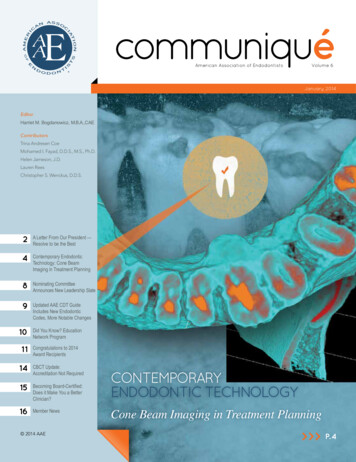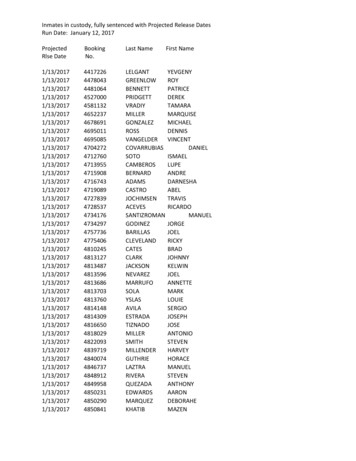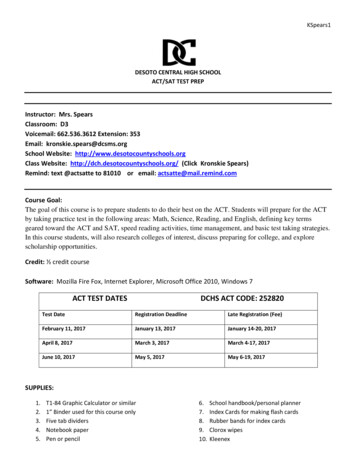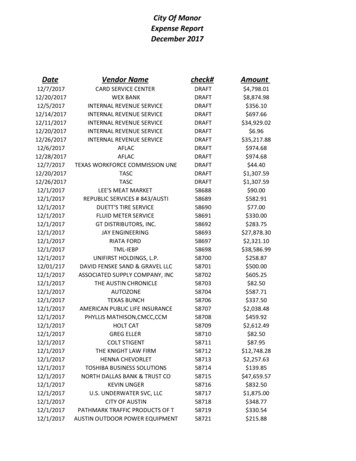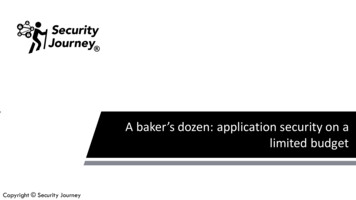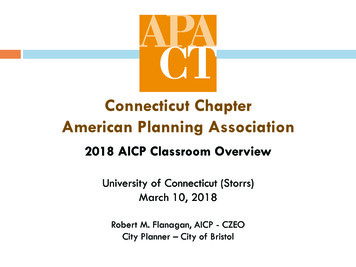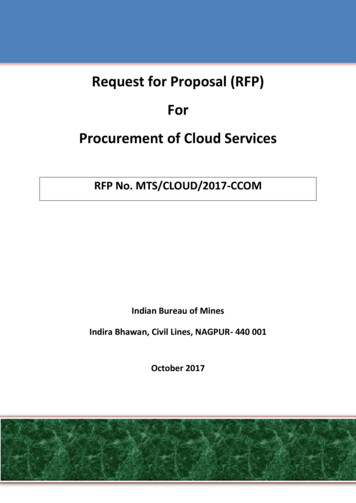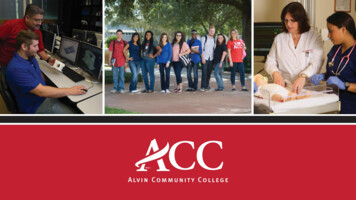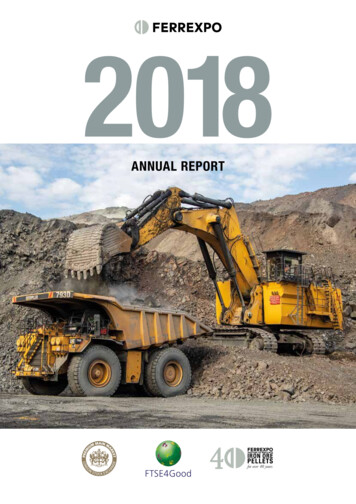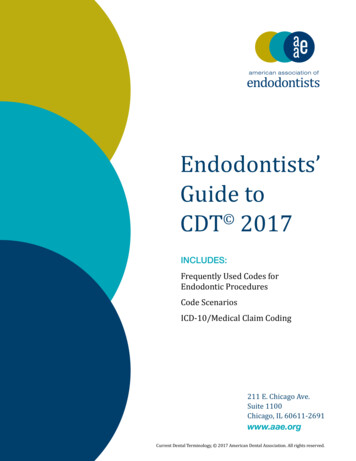
Transcription
Endodontists’Guide to CDT 2017INCLUDES:Frequently Used Codes forEndodontic ProceduresCode ScenariosICD-10/Medical Claim Coding211 E. Chicago Ave.Suite 1100Chicago, IL 60611-2691www.aae.orgCurrent Dental Terminology, 2017 American Dental Association. All rights reserved.
ContentsIntroductionSection I:Frequently Used Codes for Endodontic Procedures234–14Section II:Code Scenarios15–32Section III:ICD-10/Medical Claim Coding33–35American Association of Endodontists Endodontists’ Guide to CDT 2017
IntroductionThe Endodontists’ Guide to CDT 2017 was developed by the American Association of Endodontists forendodontists and their office staff. The Guide is designed to supplement the American Dental Association’sCDT 2017: Current Procedure Codes by illustrating the proper use of procedural codes commonly encounteredin an endodontic practice The CDT is revised annually, and effective January 1, 2017, dental practices areexpected to use CDT 2017 in claims submissionsThe Guide includes all endodontic CDT codes (D3000-D3999) and a selection of other codes commonly usedby endodontic practices However, the Guide does not include all CDT codes that an endodontic practicemight use The Guide includes a new section, “ICD-10/Medical Claim Coding” to assist in filing dental claimswith medical insurers The AAE strongly encourages endodontic practices to purchase the ADA CDT 2017 If adental insurance claim is filed using an outdated version of CDT, it will be delayed or even denied. In addition,the ADA’s guide includes important information on completing the ADA dental claim form medical codesThe Guide does not contain any changes to endodontic codes The code change most likely to be used byendodontic practices is:D9311consultation with a medical health care professionalThe AAE has additional online resources available for members on dental benefit plans and claimsprocessingCDT codes and terminology are the copyright property of the American Dental Association and are used withpermission All other content is copyright property of the American Association of Endodontists No portionof this publication may be used without permissionThe AAE wishes to thank the AAE Practice Affairs Committee for their work on this publication and theirongoing advocacy on behalf of AAE members on coding-related issues.Current Dental Terminology, 2017 American Dental Association All rights reservedSection I: Frequently Used Codes for Endodontic Procedures3
Section IFrequently UsedCodes for EndodonticProcedures
Code on Dental Procedures and Nomenclature (CDT)These represent the dental codes used most frequently by endodontists, effective for the period January 1,2017-December 31, 2017When nomenclature includes a “by report” notation, attach a detailed narrative explaining the treatmentcompletedInformation in italics was provided by the AAE.I. Diagnostic D0100-D0999Clinical Oral EvaluationsThe codes in this section recognize the cognitive skills necessary for patient evaluation The collectionand recording of some data and components of the dental examination may be delegated; however, theevaluation, diagnosis and treatment planning are the responsibility of the dentist As with all ADA procedurecodes, there is no distinction made between the evaluations provided by general practitioners andspecialists. Report additional diagnostic and/or definitive procedures separately.D0120periodic oral evaluation – established patientTypically, this code is not used in an endodontic practice. It generally is used for new patientexams administered by a general dentist or periodontist.D0140limited oral evaluation – problem focusedAn evaluation limited to a specific oral health problem. This may require interpretation ofinformation acquired through additional diagnostic procedures Report additional diagnosticprocedures separately. Definitive procedures may be required on the same date as theevaluationTypically, patients receiving this type of evaluation have been referred for a specific problemand/or present with dental emergencies, trauma, acute infections, etcD0150comprehensive oral evaluation – new or establishedTypically this code is not used in an endodontic practice.D0160detailed and extensive oral evaluation – problem focused, by reportA detailed and extensive problem-focused evaluation entails extensive diagnostic andcognitive modalities based on the findings of a comprehensive oral evaluation. Integrationof more extensive diagnostic modalities to develop a treatment plan for a specific problemis required The condition requiring this type of evaluation should be described anddocumentedExamples of conditions requiring this type of evaluation may include dentofacial anomalies,complicated perio-prosthetic conditions, complex temporomandibular dysfunction, facialpain of unknown origin, severe systemic diseases requiring multi-disciplinary consultation,etcSection I: Frequently Used Codes for Endodontic Procedures5
D0170re-evaluation-limited, problem focused (Established patient; not post-operative visit)Assessing the status of a previously existing condition For example: a traumatic injury where no treatment was rendered but patient needs follow-upmonitoring; evaluation for undiagnosed continuing pain; soft tissue lesion requiring follow-up evaluationD0171re-evaluation – post-operative office visitDiagnostic ImagingImage Capture with InterpretationShould be taken only for clinical reasons as determined by the patient’s dentist Should be of diagnosticquality and properly identified and dated. Is a part of the patient’s clinical record and the original imagesshould be retained by the dentist. Originals should not be used to fulfill requests made by patients or thirdparties for copies of recordsD0220intraoral – periapical first radiographic imageD0230intraoral – periapical each additional radiographic imagePost Processing of Image or Image SetsD0393treatment simulation using 3D image volumeThe use of 3D image volumes for simulation of treatment including, but not limited to, dentalimplant placement, orthognathic surgery and orthodontic movementD0394digital subtraction of two or more images or image volumes of the same modalityTo demonstrate changes that have occurred over timeD0395fusion of two or more 3D image volumes of one or more modalitiesTests and Laboratory ExaminationsD0460pulp vitality testsIncludes multiple teeth and contralateral comparison(s), as indicated6American Association of Endodontists Endodontists’ Guide to CDT 2017
III. Restorative D2000-D2999Local anesthesia is usually considered to be part of Restorative proceduresA one-surface posterior restoration is one in which the restoration involves only one of the five surfaceclassifications (mesial, distal, occlusal, lingual, or facial, including buccal and labial.)A two-surface posterior restoration is one in which the restoration extends to two of the five surfaceclassifications.A three-surface posterior restoration is one in which the restoration extends to three of the five surfaceclassifications.A four-or-more surface posterior restoration is one in which the restoration extends to four or more of thefive surface classifications.A one-surface anterior proximal restoration is one in which neither the lingual nor facial margins of therestoration extend beyond the line angleA two-surface anterior proximal restoration is one in which either the lingual or facial margin of therestoration extends beyond the line angleA three-surface anterior proximal restoration is one in which both the lingual and facial margins of therestorations extend beyond the line angleA four-or-more surface anterior restoration is one in which both the lingual and facial margins extendbeyond the line angle and the incisal angle is involved This restoration might also involve all four surfaces ofan anterior tooth and not involve the incisal angleOther Restorative ServicesD2940protective restorationDirect placement of a temporary restorative material to protect tooth and/or tissueform This procedure may be used to relieve pain, promote healing or prevent furtherdeterioration Not to be used for endodontic access closure, or as a base or liner under arestorationD2950core buildup, including any pinsRefers to building up of coronal structure when there is insufficient retention for a separateextracoronal restorative procedure. A core buildup is not a filler to eliminate any undercut,box form, or concave irregularity in a preparationD2955post removalSection I: Frequently Used Codes for Endodontic Procedures7
VIII. Implant Services D6000-D6199Local anesthesia is usually considered to be part of Implant Services procedureD6010surgical placement of implant body: endosteal implantD6011second stage implant surgerySurgical access to an implant body for placement of a healing cap or to enable placement ofan abutmentX. Oral and Maxillofacial Surgery D7000-D7999Extractions(Includes local anesthesia, suturing, if needed, and routine postoperative care)D7140extraction, erupted tooth or exposed root (elevation and/or forceps removal)Includes removal of tooth structure, minor smoothing of socket bone, and closure, asnecessarySurgical Extractions(Includes local anesthesia, suturing, if needed, and routine postoperative care)D7210extraction, erupted tooth requiring removal of bone/and or sectioning of tooth, andincluding elevation of tooth structure, minor smoothing of socket bone and closure.Includes related cutting of gingiva and bone, removal of tooth structure, minor smoothing ofsocket bone and closureD7250removal of residual tooth roots (cutting procedure)Includes cutting of soft tissue and bone, removal of tooth structure, and closureOther Surgical ProceduresD7270tooth reimplantation and/or stabilization of accidentally avulsed or displaced toothIncludes splinting and/or stabilizationRemoval of Tumors, Cysts and Neoplasms Surgical Excision of Intra-osseous Lesions8D7460removal of benign nonodontogenic cyst or tumor –lesion diameter up to 1.25 cmD7461removal of benign nonodontogenic cyst or tumor –lesion diameter greater than 1.25 cmAmerican Association of Endodontists Endodontists’ Guide to CDT 2017
XII. Adjunctive General Services D9000-D9999Unclassified TreatmentD9110palliative (emergency) treatment of dental pain – minor procedureThis is typically reported on a “per visit” basis for emergency treatment of dental painD9120fixed partial denture sectioningSeparation of one or more connections between abutments and/or pontics when someportion of a fixed prosthesis is to remain intact and serviceable following sectioning andextraction or other treatment Includes all recontouring and polishing of retained portionsAnesthesiaD9210local anesthesia not in conjunction with operative or surgical proceduresD9230inhalation of nitrous oxide/analgesia, anxiolysisD9248non-intravenous conscious sedationA medically controlled state of depressed consciousness while maintaining the patient’sairway, protective reflexes and the ability to respond to stimulation or verbal commands.It includes non-intravenous administration of sedative and/or analgesic agent(s) andappropriate monitoringThe level of anesthesia is determined by the anesthesia provider’s documentation of theanesthetic’s effects upon the central nervous system and not dependent upon the route ofadministrationProfessional ConsultationD9310consultation – diagnostic service provided by dentist or physician other thanrequesting dentist or physicianA patient encounter with a practitioner whose opinion or advice regarding evaluation and/ormanagement of a specific problem; may be requested by another practitioner or appropriatesource The consultation includes an oral evaluation The consulted practitioner may initiatediagnostic and/or therapeutic servicesD9310 does not require treatment. The consulting dentist must provide a written narrative backto the referring dentist. If a dental insurer denies a D9310 on grounds that it is a non-coveredbenefit, the practice can resubmit the claim as a D0140 (limited oral evaluation). D9311consultation with a medical health care professionalTreating dentist consults with a medical health professional concerning medical issues thatmay affect patient’s planned dental treatment Identifies a new procedure code as of January 1, 2017.Section I: Frequently Used Codes for Endodontic Procedures9
Professional VisitsD9430office visit for observation (during regularly scheduled hours) – no other servicesperformedD9440office visit – after regularly scheduled hoursDrugsD9610therapeutic parenteral drug, single administrationIncludes single administration of antibiotics, steroids, anti-inflammatory drugs, or othertherapeutic medications This code should not be used to report administration of sedative,anesthetic or reversal agentsD9612therapeutic parenteral drugs, two or more administrations, different medicationsIncludes multiple administrations of antibiotics, steroids, anti-inflammatory drugs or othertherapeutic medications This code should not be used to report administration of sedatives,anesthetic or reversal agents This code should be reported when two or more differentmedications are necessary and should not be reported in addition to code D9610 on the samedateMiscellaneous ServicesD9910application of desensitizing medicamentIncludes in-office treatment for root sensitivity. Typically reported on a “per visit” basis forapplication of topical fluoride. This code is not to be used for bases, liners or adhesives usedunder restorationsD9972external bleaching – per arch – performed in officeD9973external bleaching – per toothD9974internal bleaching – per toothD9985sales taxD9986missed appointmentD9987cancelled appointmentD9999unspecified adjunctive procedure, by reportUsed for procedure that is not adequately described by a code Describe procedure10American Association of Endodontists Endodontists’ Guide to CDT 2017
IV. Endodontics D3000-D3999Pulp CappingD3110pulp cap – direct (excluding final restoration)Procedure in which the exposed pulp is covered with a dressing or cement that protects thepulp and promotes healing and repairD3120pulp cap – indirect (excluding final restoration)Procedure in which the nearly exposed pulp is covered with a protective dressing to protectthe pulp from additional injury and to promote healing and repair via formation of secondarydentin This code is not to be used for bases and liners when all caries has been removedPulpotomyD3220therapeutic pulpotomy (excluding final restoration) – removal of pulp coronal to thedentinocemental junction and application of medicament.Pulpotomy is the surgical removal of a portion of the pulp with the aim of maintaining thevitality of the remaining portion by means of an adequate dressing To be performed on primary or permanent teeth This is not to be construed as the first stage of root canal therapy. This is not to be used for apexogenesisD3221pulpal debridement, primary and permanent teethPulpal debridement for the relief of acute pain prior to conventional root canal therapy Thisprocedure is not to be used when endodontic treatment is completed on the same dayD3222partial pulpotomy for apexogenesis – permanent tooth with incomplete rootdevelopmentRemoval of a portion of the pulp and application of a medicament with the aim of maintainingthe vitality of the remaining portion to encourage continued physiological development andformation of the root. This procedure is not to be construed as the first stage of root canaltherapyEndodontic Therapy on Primary TeethEndodontic therapy on primary teeth with succedaneous teeth and placement of resorbable filling. Thisincludes pulpectomy, cleaning, and filling of canals with resorbable material.D3230pulpal therapy (resorbable filling) – anterior, primary tooth(excluding final restoration)Primary incisors and cuspidsD3240pulpal therapy (resorbable filling) – posterior, primary tooth(excluding final restoration)Primary first and second molars.Section I: Frequently Used Codes for Endodontic Procedures11
Endodontic Therapy(Including Treatment Plan, Clinical Procedures and Follow-Up Care)Includes primary teeth without succedaneous teeth and permanent teeth Complete root canal therapy;pulpectomy is part of root canal therapyIncludes all appointments necessary to complete treatment; also includes intra-operative radiographs Doesnot include diagnostic evaluation and necessary radiographs/diagnostic imagesD3310endodontic therapy, anterior tooth (excluding final restoration)D3320endodontic therapy, bicuspid tooth (excluding final restoration)D3330endodontic therapy, molar (excluding final restoration)D3331treatment of root canal obstruction; non-surgical accessIn lieu of surgery, the formation of a pathway to achieve an apical seal without surgicalintervention because of a non-negotiable root canal blocked by foreign bodies, included butnot limited to separated instruments, broken posts or calcification of 50% or more of therootsD3332incomplete endodontic therapy; inoperable, unrestorable or fractured toothConsiderable time is necessary to determine diagnosis and/or provide initial treatmentbefore the fracture makes the tooth unretainableD3333internal root repair of perforation defectsNon-surgical seal or perforation caused by resorption and/or decay but not iatrogenic byprovider filing claim.Endodontic RetreatmentD3346retreatment of previous root canal therapy – anteriorD3347retreatment of previous root canal therapy – bicuspidD3348retreatment of previous root canal therapy – on/recalcification – initial visit (apical closure/calcific repair of perforations,root resorption, etc.)Includes opening tooth, preparation of canal spaces, first placement of medication andnecessary radiographs. (This procedure may include first phase of complete root canaltherapy )D3352apexification/recalcification – interim medication replacement (apical closure/calcificrepair of perforations, root resorption, pulp space, disinfection, etc.)For visits in which the intra-canal medication is replaced with new medication Iincludes anynecessary radiographs12American Association of Endodontists Endodontists’ Guide to CDT 2017
D3353apexification/recalcification – final visit (includes completed root canal therapy –apical closure/calcific repair of perforations, root resorption, etc.)Includes removal of intra-canal medication and procedures necessary to place final rootcanal filling material including necessary radiographs. (This procedure includes last phase ofcomplete root canal therapy )Pulpal RegenerationD3355pulpal regeneration – initial visitIncludes opening tooth, preparation of canal spaces, placement of medicationD3356pulpal regeneration – interim medication replacementD3357pulpal regeneration – completion of treatmentDoes not include final restoration.Apicoectomy/Periradicular ServicesPeriradicular surgery is a term used to describe surgery to the root surface (e g apicoectomy), repair of aroot perforation or resorptive defect, exploratory curettage to look for root fractures, removal of extrudedfilling materials or instruments, removal of broken root fragments, sealing of accessory canals, etc. This doesnot include retrograde filling material placement.D3410apicoectomy – anteriorFor surgery on root of anterior tooth. Does not include placement of retrograde fillingmaterialD3421apicoectomy – bicuspid (first root)For surgery on one root of a bicuspid. Does not include placement of retrograde fillingmaterial If more than one root is treated, see D3426D3425apicoectomy – molar (first root)For surgery on one root of a molar tooth. Does not include placement of retrograde fillingmaterial If more than one root is treated, see D3426D3426apicoectomy (each additional root)D3427Typically used for bicuspids and molar surgeries when more than one root is treated duringthe same procedure. This does not include retrograde filling material placement.D3428bone graft in conjunction with periradicular surgery – per tooth, single siteperiradicular surgery without apicoectomyIncludes non-autogenous graft materialD3429bone graft in conjunction with periradicular surgery – each additional contiguoustooth in the same surgical siteIncludes non-autogenous graft materialSection I: Frequently Used Codes for Endodontic Procedures13
D3430retrograde filling – per rootD3431For placement of retrograde filling material during periradicular surgery procedures. If morethan one filling is placed in one root, report as D3999 and describe.biologic materials to aid in soft and osseous tissue regeneration in conjunction withperiradicular surgeryD3432guided tissue regeneration, resorbable barrier, per site, in conjunction withperiradicular surgeryD3450root amputation – per rootRoot resection of a multi-rooted tooth while leaving the crown If the crown is sectioned, seeD3920D3460endodontic endosseous implantPlacement of implant material which extends from a pulpal space into the bone beyond theend of the rootD3470intentional reimplantation (including necessary splinting)For the intentional removal, inspection and treatment of the root and replacement of a toothinto its own socket. This does not include necessary retrograde filling material placementOther Endodontic ProceduresD3910surgical procedure for isolation of tooth with rubber damD3920hemisection (including any root removal), not including root canal therapyIncludes separation of a multi-rooted tooth into separate sections containing the root andthe overlying portion of the crown It may also include the removal of one or more of thosesectionsD3950canal preparation and fitting of preformed dowel or postShould not be reported in conjunction with D2952, D2953, D2954 or D2957 by the samepractitionerD3999unspecified endodontic procedure, by reportUsed for procedure that is not adequately described by a code Describe procedure14American Association of Endodontists Endodontists’ Guide to CDT 2017
Section IICode Scenarios
Code ScenariosThe following scenarios address procedures commonly encountered in an endodontic practice and illustrateproper application of the associated codesSee pages 16–29 for complete nomenclature and descriptorEndodontic RetreatmentDiagnosticNew Patient Exam16Retreatment23Endodontist Consultation16Retreatment with Canal Obstruction2417Surgical Endodontic TreatmentEmergency TreatmentEmergency Endodontic ProcedureTreatment of an Avulsed Tooth (with a MatureApex with or without root resorption)17Surgical Endodontic Treatment:Apicoectomy24Vital Pulp TreatmentSurgical Endodontic Treatment:Periradicular Surgery25Bone Graft in Conjunction withPeriradicular Surgery, includingGuided Tissue Regeneration25Exploratory Surgery – Fractured Tooth26Extraction and Intentional Reimplantation27Root Amputation27Hemisection27Sedative Filling/Protective Restoration18Apexogenesis18Pulpal Regeneration(Regenerative Endodontics)Apexification19Endodontic TreatmentOther ServicesExploratory Endodontic Procedure 121Post Removal28Exploratory Endodontic Procedure 221Surgery for Isolation of Toothwith Rubber Dam28Crown Lengthening28Endodontic Treatment with CanalObstruction1621Endodontic Treatment with Perforation Repair(Succedaneous Tooth Present)22Access Cavity Closure29Core Buildup29Endodontic Treatment on a Primary Tooth(No Succedaneous Tooth Present)22Postspace Preparation and Fittingof a Preformed Post29Incision and Drainage with or withoutRoot Canal Treatment23Placement of a Preformed Postand Core Buildup29American Association of Endodontists Endodontists’ Guide to CDT 2017
DiagnosticNew Patient Exam – Endodontic TreatmentA patient is referred for diagnosis of pain in the upper left quadrant The patient has had sensitivity to coldtemperatures for several months Several weeks ago, the pain to cold temperatures diminished and is nowabsent However, for the past week, the patient has had a spontaneous toothache, which comes and goes Thepatient is not sure where the source of his/her pain is The referring dentist took a radiograph, which he saiddid not show anything, and referred the patient to youThe patient is new to your office. The patient completes a new patient health history form. Two radiographsof the upper left quadrant are taken You interview the patient about the history of this pain Diagnostic pulptesting reveals that tooth #14 is more sensitive to percussion than the adjacent teeth No tooth was painfulto cold testing, but #14 did not respond at all to cold stimulation Electric pulp testing revealed no responsefrom #14You inform the patient that tooth #14 has a necrotic pulp and requires root canal treatmentAppropriate CDT Codes:D0140limited oral evaluation – problem focusedD0220intraoral – periapical first radiographic imageD0230intraoral – periapical each additional radiographic imageD0460pulp vitality testsThe patient agrees to have endodontic treatment which may be performed that day or at a futureappointmentAn insurance claim for molar root canal treatment is filed on the day endodontic treatment is completed:Appropriate CDT Codes:D3330endodontic therapy, molar (excluding final restoration)Section II: Code Scenarios17
Endodontist ConsultationA patient is referred for diagnosis of pain in the upper left quadrant The patient has had pain off and onfor several months A swelling has developed in the past several days adjacent to tooth #14 There are deepcaries in this tooth The referring dentist tells the patient he needs a root canal and refers the patient to youroffice. Radiographs and diagnostic pulp testing are performed. However, upon examination, you determinethat the tooth is untreatable due to caries/periodontal disease/fracture -or- the patient decides that hewould rather have the tooth removed. The patient leaves your office without any endodontic treatment beingperformedAppropriate CDT Codes:D9310consultation – diagnostic service provided by dentist or physician other thanrequesting dentist or physicianD0220intraoral – periapical first radiographic imageD0460pulp vitality testsSome insurance may not provide a benefit for consultation. If benefits are denied, the claim may beresubmitted as D0140 limited oral evaluation – problem focused However, consultation is a more accuratedescription of the service provided, and the reimbursement for this code is usually higher reflecting thefact that more time is often required Also, some insurance companies may limit patients to the number ofevaluation benefits payable during a given time period (e.g. calendar year).Emergency TreatmentEmergency Endodontic ProcedureA patient has been up all night with a toothache and has been referred to your office for emergency reliefof pain. This is your first contact with this patient for this specific problem. The patient has not beenpreviously appointed for this problem, and is being “squeezed in” to provide only emergency care at thisvisit Upon arrival, the patient is evaluated via clinical examination, periapical X-ray(s) and pulp vitalitytesting. You determine that a specific tooth has an endodontic problem. Emergency treatment is providedby anesthetizing the patient, making an access cavity opening and performing gross pulpal debridementAppropriate pain medications and antibiotics may be prescribed, and the patient is reappointed to completeroot canal treatmentAppropriate CDT Codes:18D0140limited oral evaluation – problem focusedD0220intraoral – periapical first radiographic imageD0460pulp vitality testsD3221pulpal debridement, primary and permanent teethAmerican Association of Endodontists Endodontists’ Guide to CDT 2017
The same doctor can perform this procedure and submit an insurance claim so long as endodontic treatmentis not completed on the same day as the emergency visit D3221 is intended for an unscheduled, emergencyvisit for relief of acute pain This code is not to be used for routine, scheduled, multi-appointment root canaltreatmentTreatment of an Avulsed Tooth (with a mature apex – with or without root resorption)A patient sustained an injury to tooth #8 playing basketball, and the tooth was totally avulsed The patientcalled your home and was instructed to locate the tooth, place it in an appropriate transport medium (thegym had a tooth emergency kit with Hank’s Balanced Salt Solution), and meet you immediately at your office.The dislodged tooth is replanted within thirty minutes of the accident, and a splint is placed Five sutures areplaced to close a 1 cm laceration of the lipIn seven to 10 days endodontic treatment should be initiated and calcium hydroxide placed The sutures andsplints can be evaluated for removal at that time In most cases, the root canal treatment is initiated at theend of the ideal seven-day period, external inflammatory root resorption can be prevented, and obturationcan take place within a monthIf however, the endodontic treatment is initiated when root resorption is already visible, calcium hydroxide isneeded for an extended period before obturation can take place The status of the lamina dura and presenceof the calcium hydroxide in the canal should be evaluated every three monthsAppropriate CDT Codes:D9440office visit – after regularly scheduled hoursD0140limited oral evaluation – problem focusedD0220intraoral – periapical first radiographic imageD0230intraoral – periapical each additional radiographic imageD7270tooth reimplantation and/or stabilization of accidentally avulsed or displaced toothand/or alveolusD7910suture of recent small wounds up to 5 cmD0171re-evaluation post-operative visitD0171 can be used in cases in which there is a need to check patient healing after aprocedureCDT 2017 also includes two new administrative codes that can be used for recordkeeping and any patientbilling, but are unlikely to be reimbursed by payersD9986missed appointmentD9987cancelled appointmentSection II: Code Scenarios19
Section I: Frequently Used Codes for Endodontic Procedures 3 Introduction The Endodontists' Guide to CDT 2017 was developed by the American Association of Endodontists for endodontists and their office staff. The Guide is designed to supplement the American Dental Association's CDT 2017: Current Procedure Codes by illustrating the proper use of procedural codes commonly encountered
